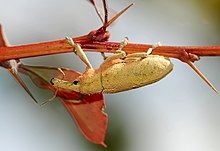Curculionidae
| True weevils and bark beetles | |
|---|---|
 |
|
| Lixus angustatus | |
| Scientific classification | |
| Kingdom: | Animalia |
| Phylum: | Arthropoda |
| Class: | Insecta |
| Order: | Coleoptera |
| Suborder: | Polyphaga |
| Infraorder: | Cucujiformia |
| Superfamily: | Curculionoidea |
| Family: |
Curculionidae Latreille, 1802 |
| Diversity | |
| Some 20 subfamilies (but see text) | |
The Curculionidae comprises the family of the "true" weevils (or "snout beetles"). It is one of the largest animal families, with 5,489 genera and 86,100 species described worldwide.
It also includes the bark beetles as subfamily Scolytinae, which are modified in shape in accordance with their wood-boring lifestyle. They do not much resemble other weevils, so they were traditionally considered a distinct family, Scolytidae. The family also includes the ambrosia beetles, of which the present-day subfamily Platypodinae was formerly considered the distinct family Platypodidae.
They are recognized by their distinctive long snouts and geniculate antennae with small clubs; beyond that, curculionids have considerable diversity of form and size, with adult lengths ranging from 1 to 40 mm (0.04 to 1.57 in).
Weevils are almost entirely plant feeders, and most species are associated with a narrow range of hosts, in many cases only living on a single species. With so many species to classify and over 400 genera, the taxonomy of this family is quite complicated, and authors disagree on the number and placement of various subfamilies, tribes, and subtribes.
The phylogeny of the group is complex; with so many species, a spirited debate exists about the relationships between subfamilies and genera. A 1997 analysis attempted to construct a phylogeny based mainly on larval characteristics.
Recent work on the phylogenetic relationships in weevils mentions the two subfamily groups Adelognatha (short-nosed weevils, subfamily Entiminae) and Phanerognatha (long-nosed weevils, subfamilies of Curculionidae other than Entiminae) for the species of Curculionidae.
Almost two dozen subfamilies are recognized by some authors even when merging those that are certainly invalid. Others, however, recognize a lesser number – the only subfamilies that are almost universally considered valid are the Baridinae, Cossoninae, Curculioninae, Cyclominae, Entiminae, Molytinae, Platypodinae, and Scolytinae. The various proposed taxonomic schemes typically recognize as many additional subfamilies again, but little agreement is seen between authorities about which. In particular, the delimitation of the Molytinae has proven difficult.
...
Wikipedia
